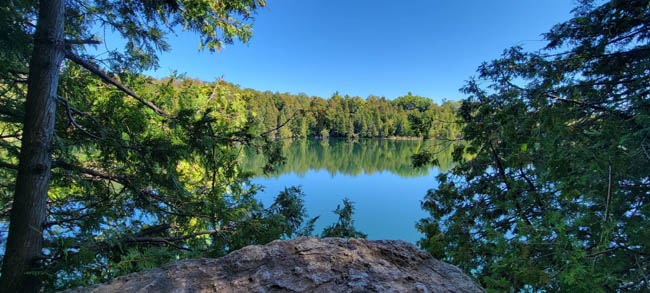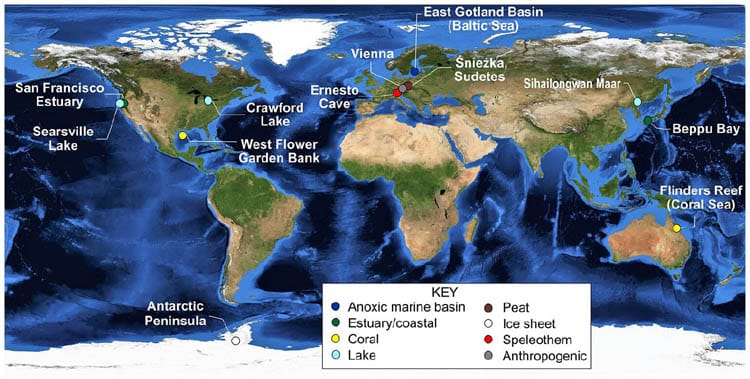
Crawford Lake is in the traditional territory of the Huron-Wendat, Neutral, and Haudenosaunee peoples.
Ian Angus is the editor of Climate & Capitalism, and the author of Facing the Anthropocene: Fossil Capitalism and the Crisis of the Earth System.
by Ian Angus
In a major step towards formal recognition of the Anthropocene as a new stage in Earth System history, scientists have identified a small lake near Toronto as the best marker of epochal change. The announcement was made at news conferences in Europe on July 11, 2023.
Tiny Crawford Lake covers just 2.4 hectares (6 acres) in a legally protected conservation area. Unusually, it is meromictic — the upper and lower layers of water do not intermix. As a result, centuries of sinking materials have combined with seasonal calcium deposits to form sharply defined annual layers of sediment — comparable to tree rings — a precise year-by-year record of local, regional and global environment change.
Studies of pollens found in Crawford sediments provide detailed information about indigenous communities that farmed corn (maize) near the lake 600 years ago, and about the environmental impacts of later land clearing and logging by European colonists.
In frozen cores pulled from the lake bottom (see video below) more recent layers contain materials that simply didn’t exist before the middle of the 20th century. A multidisciplinary scientific working group that calls itself “Team Crawford” has found carbon particles from high energy power production, nitrates from massive application of chemical fertilizers, and other recent pollutants including indicators of decades of acid rain, all first appearing about 1950, Most important, the first layer to contain radioactive plutonium isotopes was formed in 1952 — that’s when the U.S. military began testing thermonuclear weapons (hydrogen bombs) in the Pacific Ocean.
In short, sediments in the bottom of Crawford Lake contain clear evidence of what scientists have dubbed the Great Acceleration of environmental change that began about 1950.
Interviewed by The Washington Post, British geologist Colin N. Waters, chair of the Anthropocene Working Group (AWG), called the mid-century division “a very precise geochemical boundary that is present across the planet, across all environments.” To ensure that future scientists can study the evidence, a frozen sediment core from Crawford Lake is stored in the Canadian Museum of Nature’s National Biodiversity Cryobank.
Crawford Lake was one of twelve locations submitted by Earth System scientists around the world for consideration by the Anthropocene Working Group as a possible Global boundary Stratotype Section and Point (GSSP), colloquially known as a “golden spike.” As AWG Chair Colin Waters and colleagues wrote recently, the sites were not only all strong GSSP candidates, they clearly showed that a new global epoch began in the mid-20th century.
“All sites examined, from widely varying and globally distributed environments, include or delimit an interval that may be clearly referred to the Anthropocene … usually on the basis of multiple stratigraphic signals. This analytical exercise has hence emphasized the stratigraphic reality of the Anthropocene, as well as providing the factual basis for formal definition.
Most of the site teams identified the presence of plutonium as the primary indicator of the beginning of the Anthropocene.

Short List: 12 locations were considered as possible “Golden Spikes” to define the beginning of the Anthropocene epoch. (Anthropocene Review, February 2023)
It took three rounds of voting, which shows how closely matched the candidates were, but the AWG finally selected Crawford Lake as the location that best represents the start of the Anthropocene epoch.
Francine McCarthy, a geologist at nearby Brock University and member of the AWG, told The Guardian that there is now “compelling evidence globally of a massive shift, a tipping point, in the Earth’s system. Crawford Lake is so special because it allows us to see at annual resolution the changes in Earth history.”
Despite the strong evidence collected by the AWG, official acceptance of the Anthropocene as a new epoch in the Geological Time Scale is far from certain. It must obtain 60 percent approval from two other geological committees, and then be approved by the large and conservative International Union of Geological Sciences, which will probably vote on it at the next International Geological Congress, in South Korea in August 2024
Some prominent IUGS members argue that it is too soon to formalize a new epoch — alternative suggestions include defining the Anthropocene as an Age in the ongoing Holocene epoch, or just labelling it as a loosely-defined geological event.
Stay tuned for more debate.
This video, produced by the Canadian Museum of Nature early this year, shows how cores were obtained from Crawford Lake sediments and what has been learned from them.


